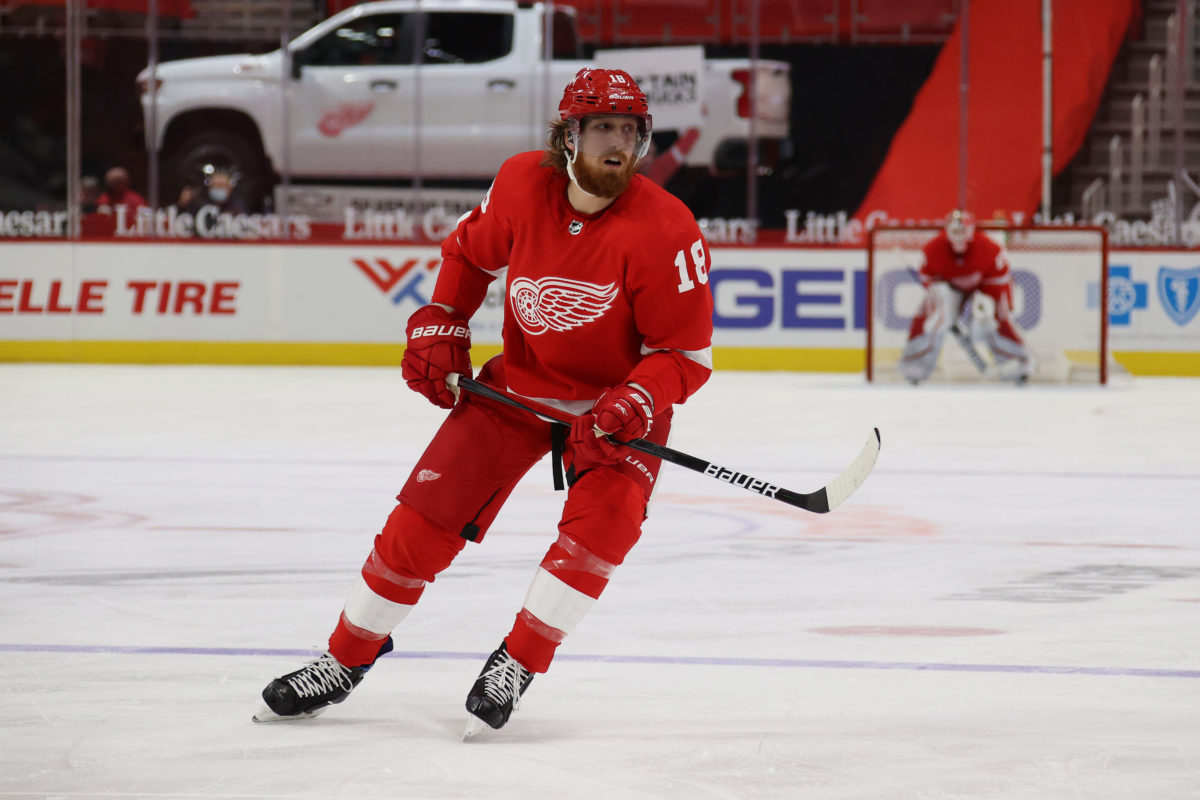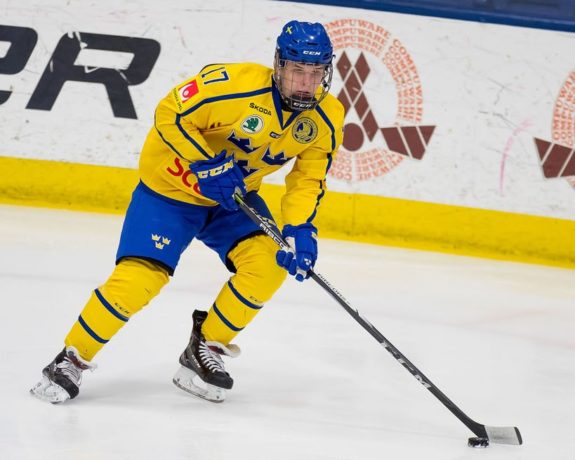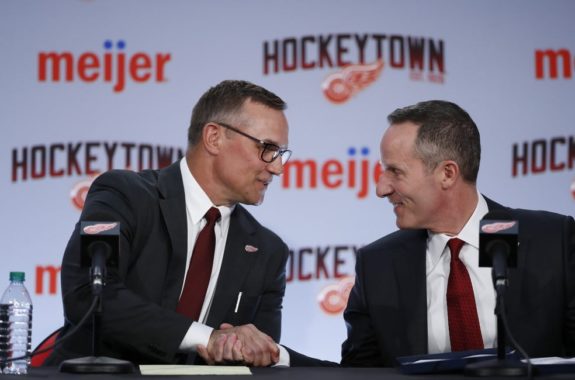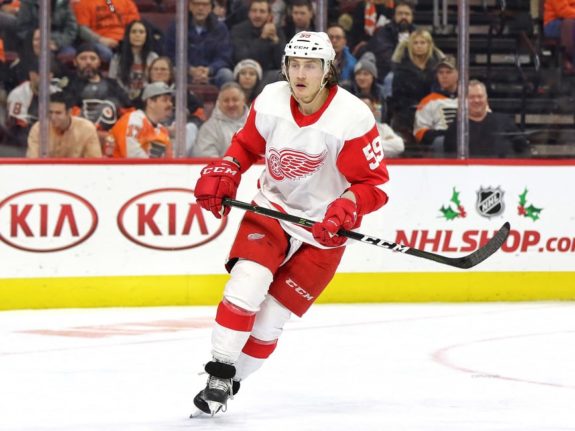The trade market is not unlike most other markets you find in the world. There are certain “items” that always sell for a high price, and there are others that are practically a dime a dozen. But, much like the stock market, other items see their value fluctuate depending on supply and demand, market trends and overall performance of that item. In the world of professional hockey, these “items” are players, and their value is almost always tied to their performance on the ice.
Anybody that is familiar with market behaviors and the stock exchange will tell you that you always want to buy low and sell high. In hockey terms, that means you ideally want to trade for a player when their value is at an abnormal low, and you want to trade or “sell” a player when their value is at an abnormal high. That’s how you maximize your return on investment and, for a rebuilding team like the Detroit Red Wings, that asset-management is critical to your current and future success.
We’ve already addressed a few players that could warrant some consideration from Red Wings general manager Steve Yzerman. Now it’s time to examine the other side of the coin. When you’re selling high, the initial impulse may be to cling to the asset because it’s performing well. It’s the ability to fight that urge and maximize your return that can be the difference between short-term and long-term success. Which players within the Red Wings’ organization are raising their value to the point where it might be time to cash-in? Let’s examine our options:
Marc Staal
The Red Wings already acquired an asset (a 2021 second round pick) from the New York Rangers just to take him and his contract off of their hands. To think about squeezing another asset out of this player just seems like another classic case of double-dipping. Furthermore, the whole reason the Rangers were willing to bribe Detroit into taking him on is the clear decline in his game when compared to his heyday. And yet, there may not be a bigger “sell-high” candidate on this team right now than Marc Staal.

While paired with fellow newcomer Troy Stecher on the Red Wings’ second defensive unit, Staal has seen something of a renaissance in his game. At 34 years old, he is experiencing his best point-production rate since the 2014-15 season, and his Corsi-percentage (49.6) is the highest it’s been since the 2013-14 season, the last year he posted positive possession numbers. He also currently leads all Red Wings defensemen with two goals on the season. We can certainly discuss and debate how much of an effect Stecher is having on Staal’s performance this season, but numbers rarely lie – this veteran defenseman isn’t done yet.
With 107 games of playoff experience, including the Rangers’ run to the Stanley Cup Final in 2014, this is the kind of guy on an expiring contract that Cup contenders look at when they aim to address their depth at the trade deadline. However, it may behoove the Red Wings to get a deal done sooner rather than later. This current uptick in performance is far from guaranteed to persist through the rest of the season. If Detroit waits to make a deal and Staal cools off and returns to the form that saw New York deal him away, then the Red Wings are likely to be saddled with him in the lineup through the end of the season.
If Red Wings general manager Steve Yzerman acts now, he can capitalize on Staal’s good start in a way that seemed unfathomable before the beginning of this season. I’m not saying Detroit could net a top-tier asset for him – they would have to retain half of his $5.7 million cap-hit just to begin the conversation – but they could very well acquire something for him. If Yzerman can say that he got two draft picks out of putting Staal in a Red Wings uniform for a bit, then that can only be viewed as a win in my book.
Jonatan Berggren
The Red Wings are rebuilding which means that, generally speaking, they’re in the business of collecting prospects, not dealing them away. However, there’s always a bit of uncertainty when it comes to projecting prospects, especially those that have a history with injuries well before they ever take the ice in the NHL. That brings us to the 33rd pick of the 2018 draft, winger Jonatan Berggren.

With the exception of defenseman Moritz Seider, Berggren has been the Red Wings’ most exciting prospect to track overseas this season. After struggling to remain healthy in the first two seasons following his draft year, he is finally looking healthy and productive this season. As of this writing, he has 10 goals and 38 points through 39 games this season with Skellefteå AIK of the SHL. He’s a mid-sized playmaker on the wings that buzzes all around the ice when he’s on his game. Quite frankly, the Red Wings could use a player with his offensive instincts on their power play to compliment guys like Anthony Mantha and Filip Zadina.
So why should the Red Wings sell high on him? The main reason is that, as I noted, he is finally looking healthy and productive after Detroit picked him early in the second round of the 2018 draft. His perceived value today is as high as its ever been, and possibly as high as it may ever be depending on how his game translates in North America. Berggren has middle-six upside, and he could make a difference for the Red Wings in two or three years, but their greatest source of depth in the organization is on the wings. In any trade, you want to deal from a position of strength – for the Red Wings, that’s on the wing.
It’s also important to note that Berggren was not drafted by Yzerman. The 2018 draft was the last one conducted by Ken Holland, the Red Wings’ former GM. While it’s reasonable to assume that Yzerman likes this player, there isn’t that degree of attachment that a manager develops when they are the ones that drafted the player. There’s even a somewhat reasonable precedent set for such a move, going back to Yzerman’s days as GM of the Tampa Bay Lightning.

On April 3, 2013, Yzerman dealt a small but skilled winger by the name of Cory Conacher to the Ottawa Senators. Conacher was an undrafted free agent that had a successful college career with Canisius College. His first full-season as a professional hockey player came during the 2011-12 season with the Norfolk Admirals, the Lightning’s AHL-affiliate at the time. The winger went on to score 80 points in 75 games, as well as 15 points in 18 playoff games. The next season, he parlayed his success at the AHL level into an opportunity with the Lightning, where he collected 24 points in 35 games. Despite that success, Yzerman dealt him to the Senators, along with a fourth round pick, in exchange for goaltender Ben Bishop.
Since that trade, Conacher went on to have varying levels of success, though never as much as he did in those first two seasons within the Lightning organization. Bishop, on the other hand, became a Vezina-caliber goaltender that enjoyed plenty of success in Tampa Bay before being traded to the Los Angeles Kings to make way for the younger Andrei Vasilevskiy. All things considered, Yzerman won this trade, despite the initial pushback on trading a highly-skilled winger that was putting up numbers.
While their situations are not exactly the same, it shouldn’t be too hard to imagine a situation where Yzerman would consider trading Berggren. If the team trades him now, while he’s healthy and productive, they could acquire an asset that addresses a need in another area, whether it’s on the prospect or roster level. Of course, just like any hot stock, Berggren’s value could eventually exceed the value of whatever they trade him for. That’s the risk you have to weigh whenever you talk about dealing prospects.
Tyler Bertuzzi
Alright, I can already see you reaching for your pitchfork, but hear me out. As a pending restricted free agent on a one-year contract, the Red Wings may not have a more tradeable asset than Bertuzzi. The only caveat is that this is a player that might mean more to this team than any other, and that may make a potential trade hard to find.

Bertuzzi, the 58th pick of the 2013 draft, has been a force ever since he officially joined the organization at the end of the 2014-15 season. He won the Jack A. Butterfield Trophy as the most valuable player of the 2017 AHL playoffs when the Grand Rapids Griffins won their second Calder Cup championship. He averaged half-a-point per-game during his first season in the NHL. He has found chemistry alongside Dylan Larkin, the Red Wings’ captain and top center, that sees him regularly perched at the top of the Red Wings’ left wing depth chart. He plays a gritty game that fans love, and he does the little things that elevate his line from good to great.
Sounds like a player that other teams should covet, right?
Although all reports suggest that the negotiation and eventual arbitration hearing between Detroit and Bertuzzi did nothing to tarnish the relationship between the organization and player, it is curious that Yzerman gave a “prove it” deal to a player that most would say has little to prove. The Red Wings’ GM didn’t hesitate to leverage Andreas Athanasiou, another prime-aged forward, as trade bait last season, and Bertuzzi fits that mold this season. Given the style of game that “Bert” plays, it’s fair to wonder how much tread will be left on his tires once the Red Wings are competitive once again.
While I wouldn’t say that I’m advocating for Bertuzzi to be dealt, it wouldn’t surprise me one bit if Yzerman gauges the market on this gritty forward. However, as I previously mentioned, a deal may never come to fruition solely because he provides something for this team on and off the ice that would be extremely hard to replicate or replace.
A Unique Trade Market
Given the uncertainty surrounding this season, next season, the 2021 draft and pretty much anything else that involves the game of hockey, the trade market is in a very different place than it normally is. Teams aren’t eager to add payroll unless it is well worth their while, or they can send similar payroll back in the deal. While you should still expect to see trades around trade deadline time, there may not be as many “big swings” as there are in other years. However, that shouldn’t prevent Yzerman from doing his due-diligence in looking to offload as many pieces as he can.
While you can’t always time these deals perfectly, it is always in the seller’s best interest to sell when the asset is at their peak value. The Red Wings certainly have some pieces that fit that criteria, and they should not hesitate to make a move if a good offer becomes available – even if it means saying goodbye to a piece that they would otherwise like to keep. Of course, like the art of a good trade and a ballroom display, it takes two to tango.
What do you think? Should the Red Wings sell high on these three players? Are there any sell-high candidates that I missed? Share your thoughts down below!
Want more Red Wings content? Tune into The Hockey Writers’ Grind Line — a new weekly live show on YouTube and Facebook. We stream Friday nights starting at 8:30 pm ET on The Hockey Writers YouTube channel. Check out this week’s show below, and make sure you subscribe to the channel so you don’t miss any upcoming shows.